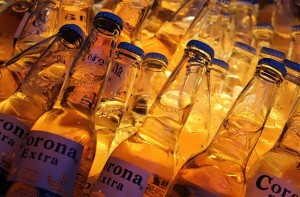So What Makes Corona Fizz?

I am not a beer drinker – I don’t particularly like it and prefer wine or scotch whenever I am in the mood. But many of my friends are habitual beer drinkers and can down quite a few pints during an afternoon or evening. While many of them are not regular Corona drinkers, they do consider it the ultimate beer and are likely to order it at an upmarket joint; because when you want to show off a bit, you order a Corona, lime wedge and all!
Corona is the fifth largest selling beer brand in the US (and the largest selling imported beer) and outsells Heineken, the next most popular import, by almost 2:1. More importantly, while the beer market in the US is in the doldrums with many established brands losing share, some to the micro-brewers, Corona is growing at a healthy 4% – and extremely profitably. Constellation Brands, which has the US rights to Corona, is laughing all the way to the bank.
What, of course, is most intriguing is that the beer that comes in glass bottles with painted labels is NOT a particularly good beer! A BusinessWeek article pointed out that 3,200 reviews at RateBeer.com gave Corona an abysmal grade of 1.69 out of 10. The Beer Advocate gave ‘Corona an “awful” rating of 55 out of 100 and the following description: faded aromas of sulphur, faint skunk, mild cooked veggies.
Not only is Corona not very good—it’s one of the worst Mexican beers. Here’s how the folks at Beer Advocate rank other suds from south of the border.
Bohemia 77
Negra Modelo 77
Dos Equis Amber 72
Victoria 68
Modelo Especial 66
Pacifico 63
Tecate 60
Sol 58’
So how does one explain the success of Corona beer in the US (since it started getting imported in the 1970s) and other parts of the world? BusinessWeek feels that the reason is aggressive marketing. If that were true, beer brands that have been advertising heavily in the US would not have seen a steady dip in their sales.
I think the reason that Corona has been so successful is because it has followed the most important principle of good marketing – differentiation. Corona has successfully managed to differentiate itself from other beer brands and here’s how:
- Packaging. Corona comes in an attractive clear glass painted label bottle, not cans. The use of cans by beer companies is becoming increasingly popular because cans offer huge advantages over glass bottles – they weigh less, reducing expenses and carbon footprint; they keep the beer better because they don’t let light in; with a ‘double-crimped’ seal, cans are better at preventing air from getting in; they are durable and unlikely to break; and they chill better. Clear glass is about the worst possible packaging for beer but Corona has still used glass bottles to stay differentiated.
- Colour. Corona has this light yellow colour, much lighter than the colour of other beers. While it is clearly a differentiating element of Corona, the colour of the beer nearly led to its collapse in the US when, in 1987, people started talking of ‘urine in the beer’. A rumour started circulating that Mexican brewery workers were relieving themselves into the beer. Due to this potentially calamitous rumour, sales started dropping alarmingly. The distributors of Corona finally traced the rumours to a distributor of Heineken – Luce & Sons of Reno – who were promptly sued. Convincing consumers that all was well with Corona was a bigger challenge and Corona used a PR and advertising blitz to convince consumers that the pale lager did not contain any traces of the offending liquid it was rumoured to have. Thankfully, the crisis proved transitory.
- Price. While priced at the mid-end in Mexico, its country of birth, Corona was launched, as many imported beers were, as one of the highest priced beers in the US and the rest of the world.
- Consumers. The early adopters of the brand were the young, hip, affluent Yuppies. This helped in creating an image that Corona was drunk by the sophisticated and superior set. Even in India, it is the younger, more affluent lot that seems to go for Corona.
- Mystique. Corona is always served with a wedge of lime (or some citrus fruit) ensconced in the mouth. In addition, Corona has always been associated with exotic locations and tropical places. The ads don’t talk about taste or hops or extra clean water; instead the ads feature a relaxing consumer enjoying a bottle on a bright and sunny beach with warm tropical waters splashing in the background. This has created a unique mystique around the brand.
So while the product itself does not get very high ratings, as shown above, Corona is an excellent example of a brand that has created a unique and differentiated image for itself. And that has made it a success in the US and in many other countries around the world.
Visual courtesy : https://www.flickr.com/photos/yeah-design/
